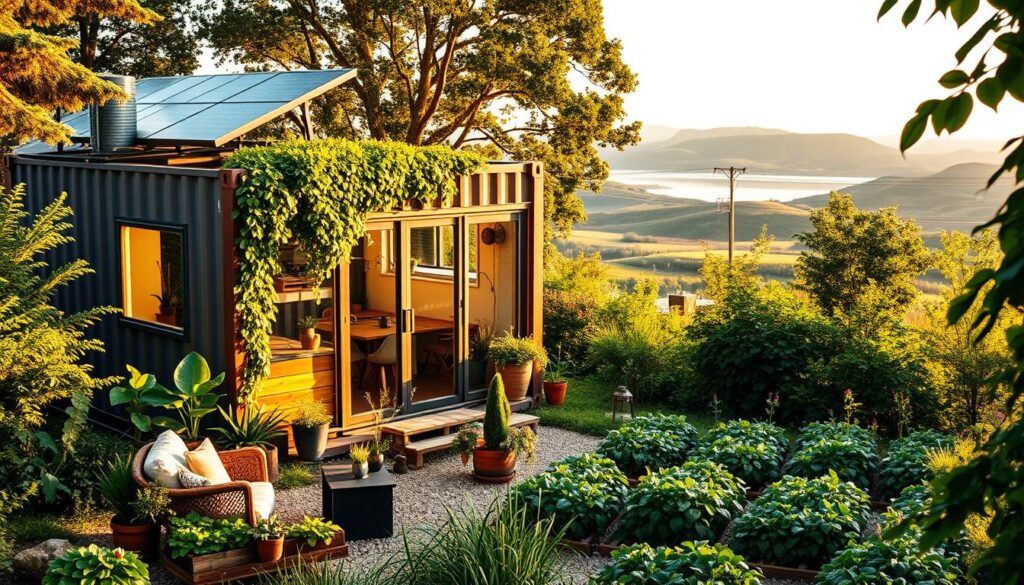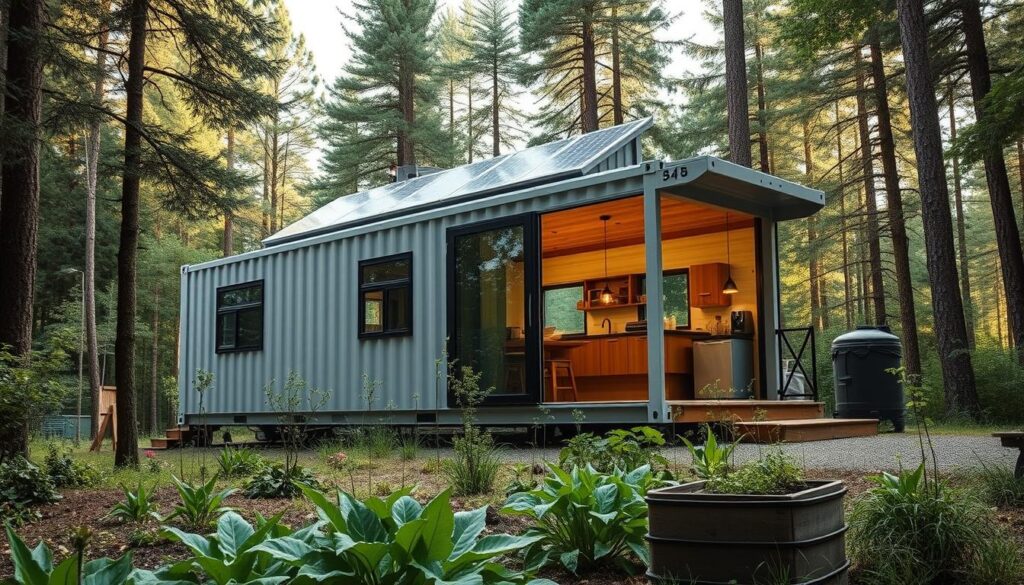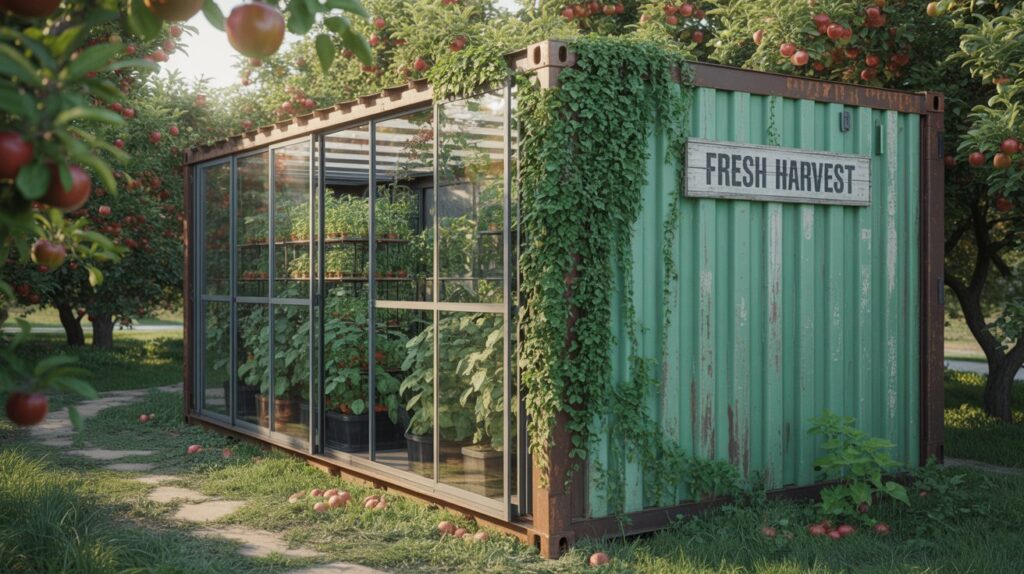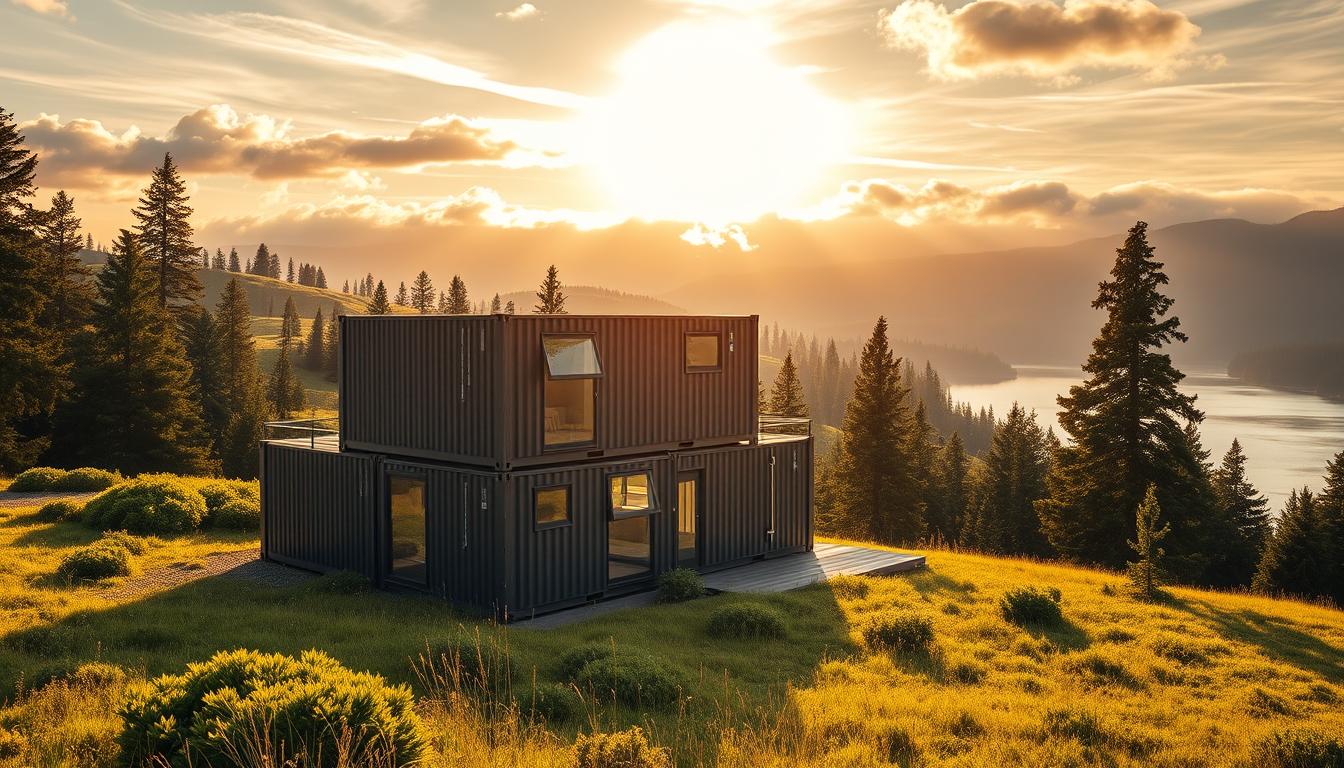Are you ready to break free from the grid and live life on your own terms? Imagine waking up to the sound of birds chirping, surrounded by nature, and living in a home that’s not only eco-friendly but also uniquely yours. With the rising trend of off-grid living, innovative housing solutions are in high demand. One such solution that’s gaining popularity is the use of shipping containers as homes.
Shipping container homes offer a sustainable and self-sufficient living option, perfect for those looking to reduce their carbon footprint. These homes are not only environmentally friendly but also provide a chance to live off the grid, away from the hustle and bustle of city life.
Key Takeaways
- Innovative ways to repurpose shipping containers for off-grid living.
- Eco-friendly features that make shipping container homes sustainable.
- Benefits of living off the grid in a shipping container home.
- Design ideas for creating a unique and self-sufficient living space.
- Tips for implementing off-grid living solutions in your shipping container home.
The Rising Trend of Container Living
Shipping containers are being repurposed as homes, offering a unique blend of sustainability and practicality. This trend is driven by the need for eco-friendly living solutions that don’t compromise on comfort or functionality.
Why Shipping Containers Are Revolutionizing Off-Grid Solutions
Shipping containers are revolutionizing off-grid living due to their inherent durability and modularity. They provide a robust structure that can withstand harsh weather conditions, making them ideal for various climates. The use of shipping containers for homes aligns with the principles of Sustainable Living with Shipping Containers, as it promotes the reuse of existing materials.
The Perfect Marriage of Sustainability and Practicality
The combination of sustainability and practicality in shipping container homes is a significant factor in their rising popularity. These homes are not only eco-friendly but also offer a cost-effective solution for Shipping Container Homes for Self-Sufficiency. By incorporating systems like solar power and rainwater harvesting, individuals can achieve a high level of self-sufficiency while minimizing their environmental footprint.
5 Ways to Use Shipping Containers for Off-Grid Living
Shipping containers are being repurposed in exciting ways to support off-grid lifestyles. The versatility of these steel structures allows for a wide range of innovative applications, from homes to workshops. Here, we’ll explore five ways to utilize shipping containers for off-grid living, highlighting their potential for sustainable and self-sufficient living.

Beyond the Box: The Incredible Versatility of Steel Containers
Shipping containers are more than just steel boxes; they’re a canvas for creativity and innovation in off-grid living. Their modular design allows for easy stacking and configuration, making them ideal for creating complex off-grid systems. The use of shipping containers for off-grid living reduces waste by repurposing existing materials, supporting eco-friendly living.
The versatility of shipping containers also extends to their ability to be modified. They can be fitted with windows, doors, and other features to create comfortable and functional living spaces. This adaptability makes them an attractive option for those looking to live off the grid.
From Global Transport to Personal Freedom
The original purpose of shipping containers was to transport goods across the globe. Now, they’re being repurposed to provide personal freedom and independence. By using shipping containers for off-grid living, individuals can create homes and communities that are self-sufficient and sustainable.
This shift from commercial use to personal living spaces represents a significant change in how we think about housing and community development. It offers a path to eco-friendly living and the freedom to live life on one’s own terms.
Idea #1: Self-Sufficient Container Homes
Embracing off-grid living, self-sufficient container homes offer a unique blend of sustainability and comfort. These innovative dwellings are designed to be independent from traditional utility grids, making them perfect for those seeking a more eco-friendly lifestyle.
Smart Design Considerations for Comfortable Living Spaces
When designing a self-sufficient container home, several factors come into play to ensure a comfortable living environment. Maximizing natural light and airflow is crucial.
Maximizing Natural Light and Airflow
To create a bright and airy atmosphere, consider installing large windows, skylights, or solar tubes. Proper ventilation can be achieved through strategically placed vents and windows that allow for cross-ventilation.
Creating Multi-Functional Areas
Given the compact nature of container homes, it’s essential to create multi-functional areas. For instance, a living room can double as a home office or guest bedroom with the use of convertible furniture.
Essential Systems for Complete Independence
A self-sufficient container home requires several essential systems to operate independently. These include:
- Reliable Renewable Energy: Solar panels or wind turbines provide the necessary power.
- Water Collection and Filtration: Systems that harvest and purify rainwater or graywater.
- Waste Management: Composting toilets and recycling facilities.

Space-Saving Techniques That Make Container Living Luxurious
To make the most of the available space, consider using vertical storage solutions, foldable furniture, and hidden compartments. A well-designed container home can feel surprisingly spacious and luxurious.
| Space-Saving Technique | Description | Benefit |
|---|---|---|
| Vertical Storage | Using wall-mounted shelves and storage units. | Maximizes floor space. |
| Foldable Furniture | Furniture that can be folded and stored when not in use. | Creates more space as needed. |
| Hidden Compartments | Storage spaces hidden behind walls or under floors. | Maintains a clutter-free environment. |
By incorporating these design considerations and systems, self-sufficient container homes can offer a comfortable, luxurious, and sustainable living experience.
Idea #2: Container Greenhouses and Food Production Systems
Container greenhouses are transforming the way we think about sustainable living and food security. By converting shipping containers into greenhouses, individuals can create a controlled environment for growing a variety of crops, regardless of the external climate.

Year-Round Growing Potential in Any Climate
The enclosed nature of shipping containers allows for the creation of microclimates, enabling year-round growing potential even in harsh or unpredictable weather conditions. This means that individuals can enjoy a consistent supply of fresh produce, irrespective of the season.
Integrating Advanced Aquaponics and Hydroponics
To maximize the efficiency of container greenhouses, many are incorporating advanced systems such as aquaponics and hydroponics. These soilless cultivation methods not only conserve water but also increase crop yields, making them ideal for sustainable food production.
“Aquaponics and hydroponics represent a significant leap forward in sustainable food production, offering a closed-loop system that minimizes waste and maximizes output.” – Expert in Sustainable Agriculture
Passive and Active Climate Control Solutions
Effective climate control is crucial for the success of container greenhouses. This involves implementing both passive and active climate control solutions, such as insulation, shading, and ventilation systems, as well as heating and cooling technologies, to maintain an optimal growing environment.
By embracing container greenhouses and advanced food production systems, individuals can significantly enhance their eco-friendly living with shipping containers, contributing to a more sustainable future.
Idea #3: Water Collection and Filtration Units
In the quest for self-sufficiency, off-grid residents are turning to shipping containers to create efficient water collection and filtration units. This innovative approach to water management is crucial for sustainable living away from municipal supplies.

Efficient Rainwater Harvesting Systems
Efficient rainwater harvesting is a cornerstone of off-grid water management. Shipping containers can be converted into large rainwater tanks or equipped with sophisticated gutter systems to maximize water collection. Advanced first flush devices can be integrated to ensure the collected water is clean and free from debris.
Sustainable Greywater Processing and Reuse
Greywater processing and reuse are vital for minimizing water waste. Shipping container-based greywater systems can be designed to treat and recycle water from sinks, showers, and washing machines. Biological treatment methods can be employed to purify greywater, making it suitable for irrigation and flushing toilets.
Innovative Water Storage and Purification Methods
Innovative water storage solutions within shipping containers include modular tank systems and advanced filtration units. These can be tailored to meet the specific needs of off-grid residents, ensuring a reliable supply of clean water. Purification methods such as UV treatment and reverse osmosis can be integrated to guarantee water quality.
By leveraging shipping containers for water collection and filtration, off-grid living becomes more sustainable and self-sufficient. This approach not only conserves water but also reduces reliance on external resources, aligning with the principles of Off-Grid Living Solutions and Shipping Container Homes for Self-Sufficiency.
Idea #4: Energy Generation and Storage Centers
As the world shifts towards sustainable living, energy generation and storage have become crucial components of off-grid lifestyles. Shipping containers can be transformed into energy hubs, providing homes with the power they need to operate independently.
Optimized Solar Panel Integration Options
Solar energy is a cornerstone of off-grid living. Containers can be equipped with solar panels that are optimized for maximum energy production. This involves careful planning of panel orientation, tilt, and configuration to capture the most sunlight throughout the day. Micro-inverters can be used to maximize energy output from each panel, ensuring that shade or dirt on one panel doesn’t reduce the output of the entire system.
Supplemental Wind and Alternative Energy Solutions
While solar power is a primary source of energy, it’s often beneficial to have supplemental energy sources. Wind turbines can be integrated into container setups to provide power during periods of low sunlight. Other alternative energy solutions, such as micro-hydroelectric systems for those with access to flowing water, can also be considered. Diversifying energy sources enhances the reliability and sustainability of off-grid container living.
Modern Battery Banks and Intelligent Power Management
Effective energy storage is critical for off-grid living. Modern battery banks, such as those using lithium-ion technology, offer high capacity and longevity. When paired with intelligent power management systems, these battery banks can optimize energy use, automatically switching between different power sources and managing energy distribution within the home. As one expert puts it,
“The key to a successful off-grid energy system is not just generating power, but storing and managing it efficiently.”
By focusing on energy generation and storage, off-grid container homes can achieve a high level of sustainability and eco-friendliness, aligning with the principles of sustainable living with shipping containers.
Idea #5: Multi-Purpose Workshop and Storage Solutions
Transforming shipping containers into multi-purpose workshops and storage solutions is a game-changer for off-grid living. This innovative approach allows residents to efficiently manage their space, tools, and equipment, enhancing overall productivity and sustainability.
Efficient Tool Organization and Flexible Workspace Design
Creating an efficient workspace within a shipping container involves thoughtful tool organization and flexible design. Modular workbenches and custom storage solutions can be tailored to fit specific needs, ensuring that every tool has its designated place. This not only saves time but also enhances safety by reducing clutter.
Creating Maintenance Facilities for All Your Off-Grid Systems
A well-designed maintenance facility within a shipping container is crucial for the upkeep of off-grid systems. This includes allocating space for routine maintenance tasks, housing necessary equipment, and storing spare parts. By having a dedicated area, residents can quickly address issues, minimizing downtime and ensuring the continuous operation of their off-grid systems.
Smart Seasonal Equipment Storage and Rotation
Smart storage solutions enable off-grid residents to efficiently manage seasonal equipment. By incorporating vertical storage racks and labeling systems, it becomes easier to store and retrieve equipment as needed. This approach not only saves space but also protects equipment from damage, extending its lifespan.
| Storage Solution | Benefits | Implementation Tips |
|---|---|---|
| Modular Workbenches | Customizable, Space-efficient | Assess your tool collection, Design with flexibility in mind |
| Vertical Storage Racks | Maximizes vertical space, Easy access | Measure your equipment, Install securely |
| Labeling Systems | Enhances organization, Saves time | Use clear labels, Update labels as inventory changes |
By incorporating these strategies, off-grid residents can create a highly functional and efficient workshop and storage solution within their shipping containers, significantly enhancing their overall living experience.
Overcoming Common Challenges in Container Conversion
One of the most significant hurdles in creating Shipping Container Homes for Self-Sufficiency is overcoming the challenges associated with their conversion. While shipping containers offer a robust foundation for off-grid living, transforming them into comfortable and sustainable spaces requires careful planning and execution.
Mastering Insulation and Temperature Control
Effective insulation is crucial for maintaining a comfortable temperature inside the container. Without proper insulation, the interior can become extremely hot in the summer and cold in the winter.
Dealing with Extreme Heat
To combat extreme heat, consider using reflective insulation or radiant barrier insulation. These materials help reflect the sun’s rays away from the container, keeping the interior cooler.
Preventing Cold Weather Problems
In colder climates, high-performance insulation such as spray foam insulation can be used to keep the container warm. Ensuring that all gaps are sealed is also crucial to prevent heat loss.
Essential Structural Modifications and Safety Considerations
Modifying the structural integrity of a shipping container is often necessary to create Eco-Friendly Living with Shipping Containers. This may involve cutting out sections for windows and doors, which can compromise the container’s strength if not done correctly.
- Consult with a professional to ensure that any modifications do not weaken the structure.
- Use proper reinforcement techniques, such as adding steel beams or headers around new openings.
By addressing these common challenges, individuals can successfully convert shipping containers into safe, comfortable, and sustainable living spaces.
Cost Analysis: Budget-Friendly Off-Grid Container Living
The financial benefits of converting a shipping container into an off-grid home are substantial, but require careful planning. To make an informed decision, it’s crucial to understand the various costs involved and how they compare to traditional housing options.
Understanding Initial Investment vs. Long-Term Savings
The initial investment for off-grid container living includes the cost of the container, conversion materials, and installation of renewable energy systems. While this initial outlay can be significant, the long-term savings on utility bills and maintenance can be substantial.
For instance, a well-insulated container home with solar panels can reduce energy costs by up to 70%. Additionally, using rainwater harvesting systems can lower water bills. Here’s a breakdown of typical costs and savings:
| Component | Initial Cost | Long-Term Savings |
|---|---|---|
| Solar Panel Installation | $15,000 – $25,000 | Up to $500/year on electricity |
| Rainwater Harvesting System | $3,000 – $5,000 | Up to $200/year on water bills |
| Insulation and Climate Control | $5,000 – $10,000 | Reduced heating/cooling costs by up to 50% |
Comparing DIY vs. Professional Conversion Costs
When it comes to converting a shipping container, one of the key decisions is whether to undertake the project yourself or hire professionals. While a DIY approach can save on labor costs, it requires significant time and expertise.
DIY Conversion can be cost-effective if you have the necessary skills. However, mistakes can lead to costly repairs down the line.
Professional Conversion, on the other hand, ensures high-quality workmanship but at a higher upfront cost.
Legal Considerations for Container Homes in the United States
Before embarking on your journey to own a shipping container home, it’s crucial to understand the legal framework governing these structures in the U.S. The legality of container homes varies significantly across different regions, making it essential for prospective homeowners to familiarize themselves with local laws and regulations.
Navigating Zoning Laws and Building Codes by Region
Zoning laws and building codes are critical factors that determine the feasibility of installing a shipping container home in a particular area. These regulations can dictate everything from the size and placement of the container to the materials used in its conversion. For instance, some jurisdictions may require container homes to adhere to traditional building codes, while others have more lenient or specific regulations for alternative dwellings.
It’s vital to research and understand the specific zoning laws and building codes in your desired location. This might involve consulting with local authorities or hiring a professional who is well-versed in these regulations.
Securing the Necessary Permits and Passing Inspections
Once you’ve determined that your container home complies with local zoning laws and building codes, the next step is to secure the necessary permits. This process typically involves submitting detailed plans of your container home for review and approval by local building authorities. Inspections may be conducted at various stages of the construction process to ensure compliance with safety and building standards.
“Understanding and complying with legal requirements is not just about avoiding fines or legal issues; it’s about ensuring your home is safe and sustainable for years to come.”
By carefully navigating these legal considerations, individuals can successfully establish their shipping container homes as viable and sustainable living solutions.
Conclusion
As we’ve explored throughout this article, shipping containers offer a versatile and sustainable solution for off-grid living. The 5 Ways to Use Shipping Containers for Off-Grid Living provide a comprehensive approach to achieving eco-friendly housing.
By repurposing shipping containers, individuals can create self-sufficient homes, greenhouses, water collection systems, energy generation centers, and multi-purpose workshops. These innovative solutions not only reduce environmental impact but also promote a more independent lifestyle.
Eco-friendly living with shipping containers is becoming increasingly popular, and for good reason. With the right design and implementation, these structures can provide comfortable, sustainable living spaces that are perfectly adapted to off-grid needs.
As the trend of container living continues to grow, it’s clear that shipping containers will play a significant role in shaping the future of eco-friendly housing. By embracing this innovative approach, we can create a more sustainable tomorrow.

